Humidity Sensitivity Behavior of CH3NH3PbI3 Perovskite
Abstract
:1. Introduction
2. Materials and Methods
2.1. Powder Preparation
2.2. Characterization of Materials
2.3. Humidity Sensor Fabrication and Performances Measurements
3. Results
3.1. Structure and Morphology Characterizations
3.2. Humidity Sensitive Properties
3.3. Influence of Light on the Humidity Sensing Properties
4. Discussion
5. Conclusions
Author Contributions
Funding
Institutional Review Board Statement
Informed Consent Statement
Data Availability Statement
Conflicts of Interest
References
- Ni, Z.Y.; Bao, C.X.; Liu, Y.; Jiang, Q.; Wu, W.Q.; Chen, S.S.; Dai, X.Z.; Chen, B.; Hartweg, B.; Yu, Z.S.; et al. Resolving spatial and energetic distributions of trap states in metal halide perovskite solar cells. Science 2020, 367, 1352–1358. [Google Scholar] [CrossRef] [PubMed]
- Juarez-Perez, E.J.; Sanchez, R.S.; Badia, L.; Garcia-Belmonte, G.; Kang, Y.S.; Mora-Sero, I.; Bisquert, J. Photoinduced giant dielectric constant in lead halide perovskite solar cells. J. Phys. Chem. Lett. 2014, 5, 2390–2394. [Google Scholar] [CrossRef] [PubMed]
- Fan, Z.; Xiao, J.X.; Sun, K.; Chen, L.; Hu, Y.T.; Quyuan, J.Y.; Ong, K.P.; Zeng, K.Y.; Wang, J. Ferroelectricity of CH3NH3Pbl3 perovskite. J. Phys. Chem. Lett. 2015, 6, 1155–1161. [Google Scholar] [CrossRef] [PubMed]
- Zhou, Y.; You, L.; Wang, S.W.; Ku, Z.L.; Fan, H.J.; Schmidt, D.; Rusydi, A.; Chang, L.; Wang, L.; Ren, P.; et al. Giant photostriction in organic-inorganic lead halide perovskites. Nat. Commun. 2016, 7, 11193. [Google Scholar] [CrossRef] [PubMed] [Green Version]
- Zhang, X.H.; Zhao, X.N.; Shan, X.Y.; Tian, Q.L.; Wang, Z.Q.; Lin, Y.; Xu, H.Y.; Liu, Y.C. Humidity effect on resistive switching characteristics of the CH3NH3PbI3 memristor. ACS Appl. Mater. Inter. 2021, 13, 28555–28563. [Google Scholar] [CrossRef] [PubMed]
- Ha, S.T.; Shen, C.; Zhang, J.; Xiong, Q.H. Laser cooling of organic-inorganic lead halide perovskites. Nat. Photonics 2016, 10, 115–121. [Google Scholar] [CrossRef]
- Cho, M.Y.; Kim, S.; Kim, I.S.; Kim, E.S.; Wang, Z.J.; Kim, N.Y.; Kim, S.W.; Oh, J.M. Perovskite-induced ultrasensitive and highly stable humidity sensor systems prepared by aerosol deposition at room temperature. Adv. Funct. Mater. 2019, 30, 1907449. [Google Scholar] [CrossRef]
- García-Fernández, A.; Moradi, Z.; Bermúdez-García, J.M.; Sánchez-Andújar, M.; Gimeno, V.A.; Castro-García, S.; Señaris-Rodriguez, M.A.; Mas-Marzá, E.; Garcia-Belmonte, G.; Fabregat-Santiago, F. Effect of environmental humidity on the electrical properties of lead halide perovskites. J. Phys. Chem. C 2018, 123, 2011–2018. [Google Scholar] [CrossRef]
- Ye, W.; Cao, Q.; Cheng, X.F.; Yu, C.; He, J.H.; Lu, J.M. Lead-free Cs2PdBr6 perovskite-based humidity sensor for artificial fruit waxing detection. J. Mater. Chem. A 2020, 8, 17675–17682. [Google Scholar] [CrossRef]
- Hu, L.; Shao, G.; Jiang, T.; Li, D.B.; Lv, X.L.; Wang, H.Y.; Liu, X.S.; Song, H.S.; Tang, J.; Liu, H. Investigation of the interaction between perovskite films with moisture via in situ electrical resistance measurement. ACS Appl. Mater. Inter. 2015, 7, 25113–25120. [Google Scholar] [CrossRef]
- Ren, K.K.; Huang, L.; Yue, S.Z.; Lu, S.D.; Liu, K.; Azam, M.; Wang, Z.J.; Wei, Z.M.; Qu, S.C.; Wang, Z.G. Turning a disadvantage into an advantage: Synthesizing high-quality organometallic halide perovskite nanosheet arrays for humidity sensors. J. Mater. Chem. C 2017, 5, 2504–2508. [Google Scholar] [CrossRef]
- Weng, Z.H.; Qin, J.J.; Umar, A.A.; Wang, J.; Zhang, X.; Wang, H.L.; Cui, X.L.; Li, X.G.; Zheng, L.R.; Zhan, Y.Q. Lead-free Cs2BiAgBr6 double perovskite-based humidity sensor with superfast recovery time. Adv. Funct. Mater. 2019, 29, 1902234. [Google Scholar] [CrossRef]
- Ilin, A.S.; Forsh, P.A.; Martyshov, M.N.; Kazanskii, A.G.; Forsh, E.A.; Kashkarov, P.K. Humidity sensing properties of organometallic perovskite CH3NH3PbI3. Chemistryselect 2020, 5, 6705–6708. [Google Scholar] [CrossRef]
- Wu, Z.L.; Yang, J.; Sun, X.; Wu, Y.J.; Wang, L.; Meng, G.; Kuang, D.L.; Guo, X.Z.; Qu, W.J.; Du, B.S.; et al. An excellent impedance-type humidity sensor based on halide perovskite CsPbBr3 nanoparticles for human respiration monitoring. Sens. Actuators B Chem. 2021, 337, 129772. [Google Scholar] [CrossRef]
- Jassim, S.M.; Bakr, N.A.; Mustafa, F.L. Synthesis and characterization of MAPbI3 thin film and its application in C-Si/perovskite tandem solar cell. J. Mater. Sci. Mater. Electron. 2020, 31, 16199–16207, Correction in 2020, 31, 16208. [Google Scholar] [CrossRef]
- Yang, J.L.; Yu, Y.; Zeng, L.Y.; Li, Y.T.; Pang, Y.Q.; Huang, F.Q.; Lin, B.L. Effects of aromatic ammoniums on methyl ammonium lead iodide hybrid perovskite materials. J. Nanomater. 2017, 1640965. [Google Scholar] [CrossRef]
- Li, W.W.; Zeng, J.G.; Zheng, L.Y.; Zeng, H.R.; Li, C.B.; Kassiba, A.; Park, C.; Li, G.R. Apparent ferroelectric-like and dielectric properties of CH3NH3PbI3 synthesized in ambient air. Ferroelectrics 2019, 553, 95–102. [Google Scholar] [CrossRef]
- Patil, D.; Seo, Y.K.; Hwang, Y.K.; Chang, J.S.; Patil, P. Humidity sensitive poly (2,5-dimethoxyaniline)/WO3 composites. Sens. Actuators B Chem. 2008, 132, 116–124. [Google Scholar] [CrossRef]
- Suri, K.; Annapoorni, S.; Sarkar, A.K.; Tandon, R.P. Gas and humidity sensors based on iron oxide-polypyrrole nanocomposites. Sens. Actuators B Chem. 2002, 81, 277–282. [Google Scholar] [CrossRef]
- Wang, Z.Y.; Shi, L.Y.; Wu, F.Q.; Yuan, S.; Zhao, Y.; Zhang, M.H. Structure and humidity sensing properties of La1-xKxCo0.3Fe0.7O3-δ perovskite. Sens. Actuators B Chem. 2011, 158, 89–96. [Google Scholar] [CrossRef]
- Yao, P.J.; Wang, J.; Ji, M. Study on dielectric and humidity sensing properties of La1-xSrxFeO3 materials. Ferroelectrics 2010, 402, 79–88. [Google Scholar] [CrossRef]
- Rao, M.C.; Srikumar, T.; Satish, D.V.; Krishna, J.S.R.; Rao, C.S.; Rao, C.R. Effect of zinc stannate nanofiller on PVA-CH3COONa polymer electrolyte for humidity sensor application. AIP Conf. Proc. 2018, 1992, 040022. [Google Scholar]
- Farahani, H.; Wagiran, R.; Urban, G.A. Investigation of room temperature protonic conduction of perovskite humidity sensors. IEEE Sens. J. 2020, 21, 9657–9666. [Google Scholar] [CrossRef]
- Sundaram, R.; Raj, E.S.; Nagaraja, K.S. Microwave assisted synthesis, characterization and humidity dependent electrical conductivity studies of perovskite oxides, Sm1-xSrxCrO3 (0 ≤ x ≤ 0.1). Sens. Actuators B Chem. 2004, 99, 350–354. [Google Scholar] [CrossRef]
- Lin, W.D.; Liao, C.T.; Chang, T.C.; Chen, S.H.; Wu, R.J. Humidity sensing properties of novel graphene/TiO2 composites by sol-gel process. Sens. Actuators B Chem. 2015, 209, 555–561. [Google Scholar] [CrossRef]
- Haque, M.A.; Syed, A.; Akhtar, F.H.; Shevate, R.; Singh, S.; Peinemann, K.V.; Baran, D.; Wu, T. Giant humidity effect on hybrid halide perovskite microstripes: Reversibility and sensing mechanism. ACS Appl. Mater. Inter. 2019, 11, 29821–29829. [Google Scholar] [CrossRef]
- Prochowicz, D.; Franckevičius, M.; Cieślak, A.M.; Zakeeruddin, S.M.; Grätzel, M.; Lewiński, J. Mechanosynthesis of the hybrid perovskite CH3NH3PbI3: Characterization and the corresponding solar cell efficiency. J. Mater. Chem. A 2015, 3, 20772–20777. [Google Scholar] [CrossRef]

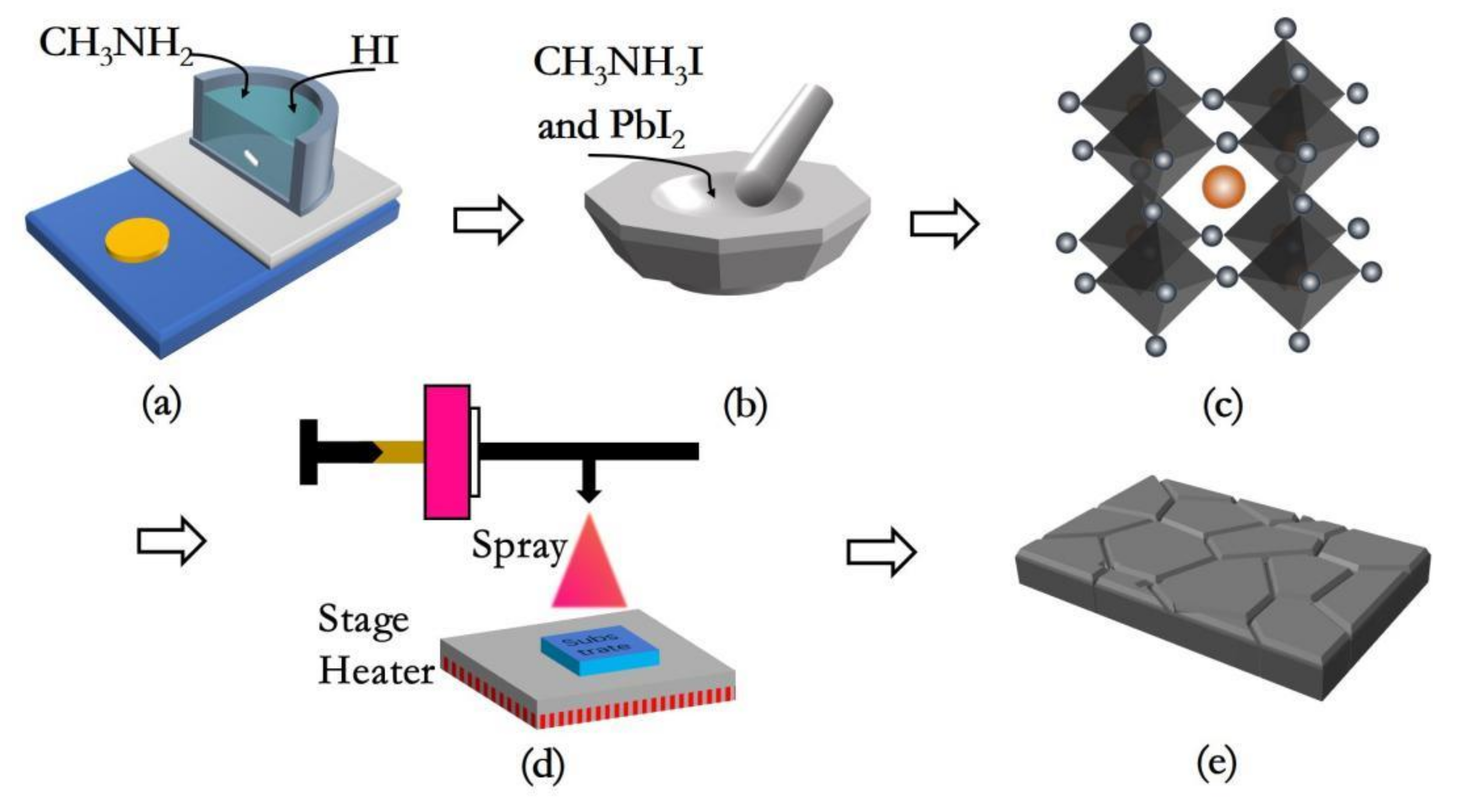
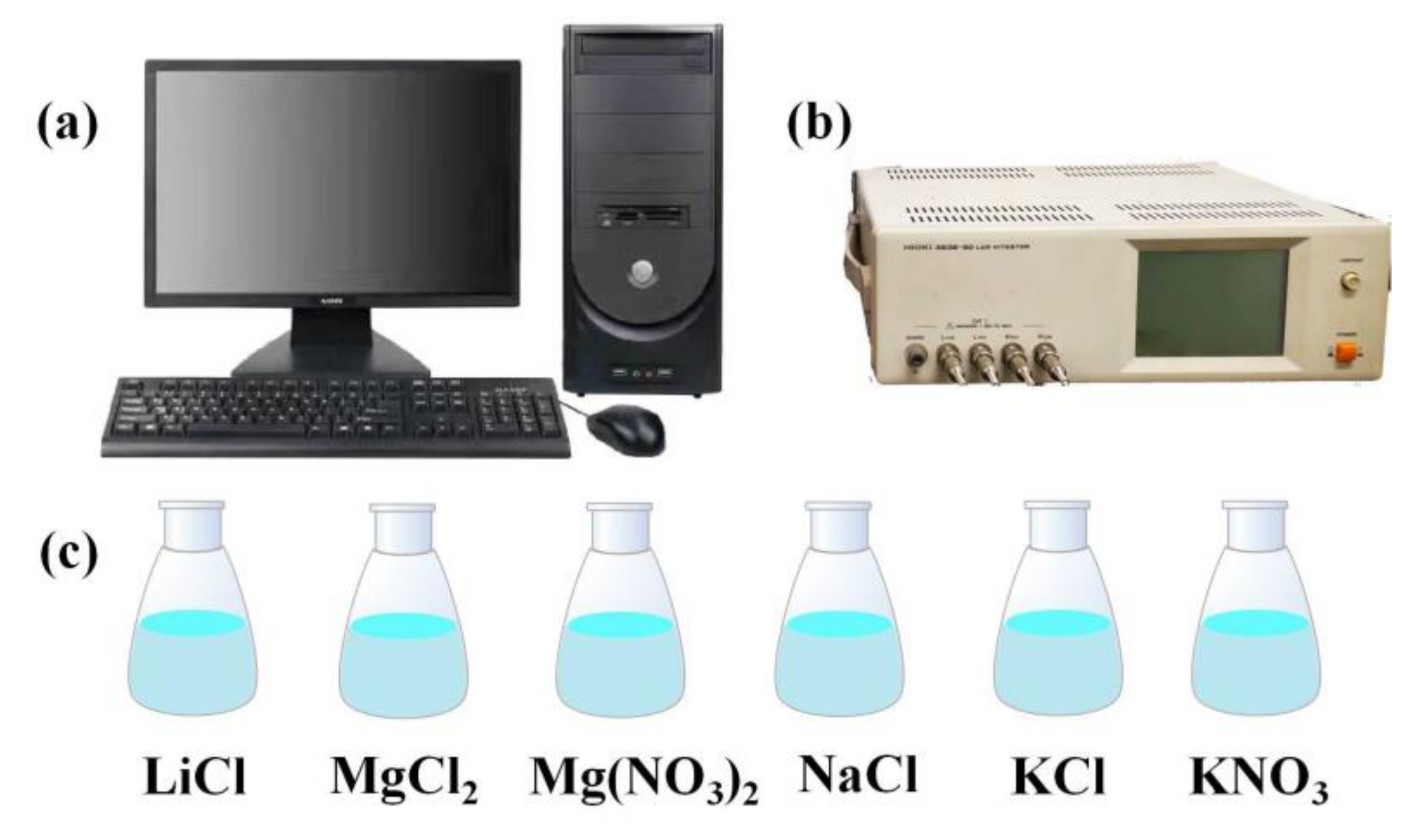
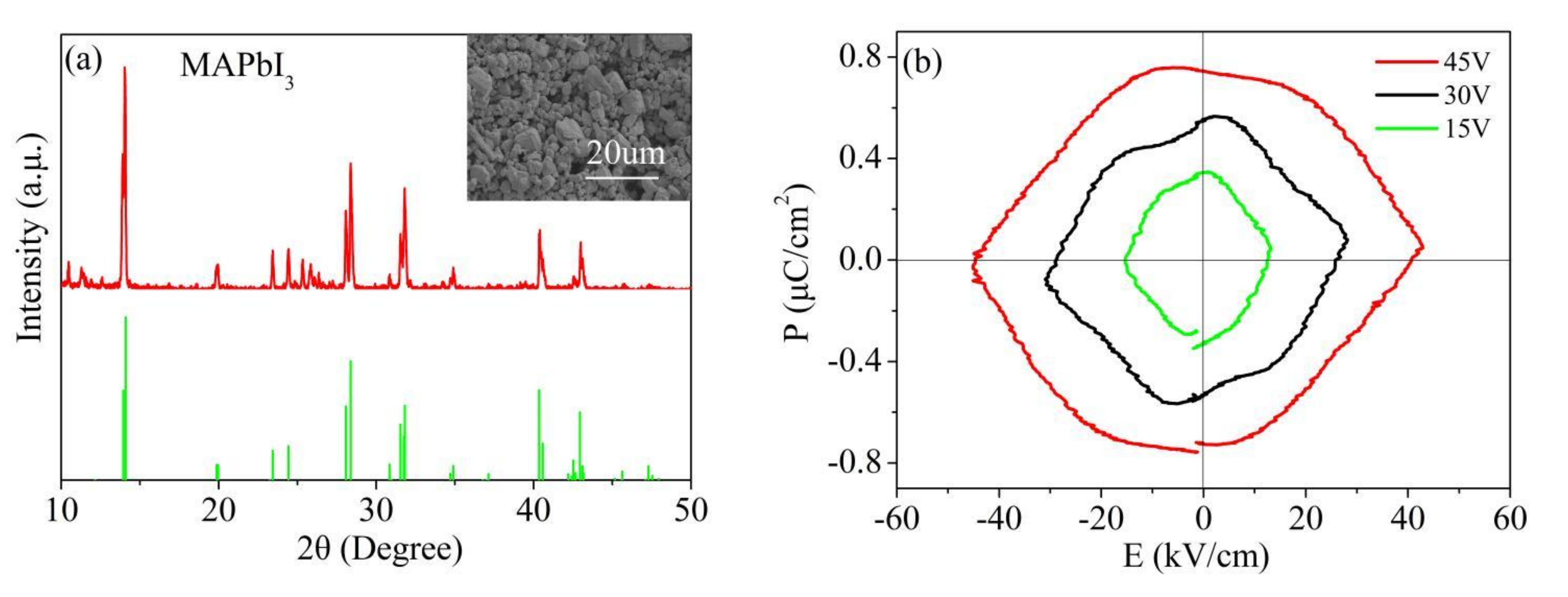

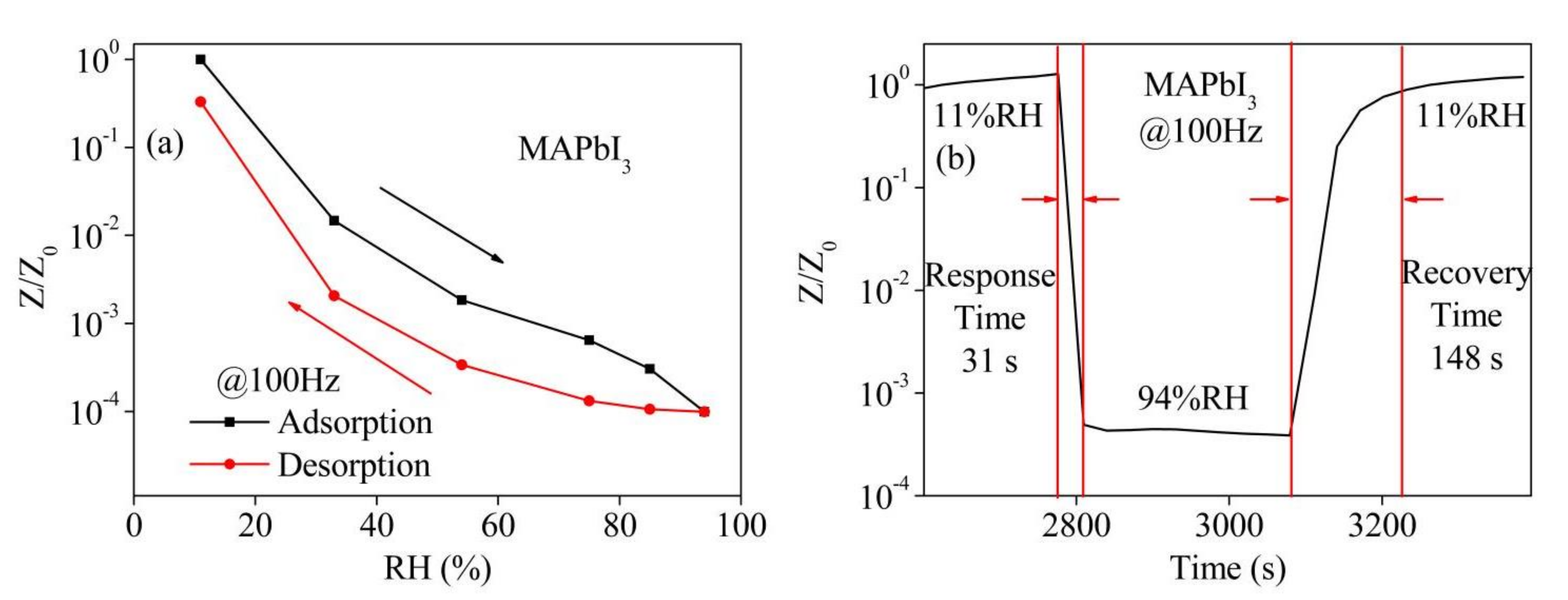


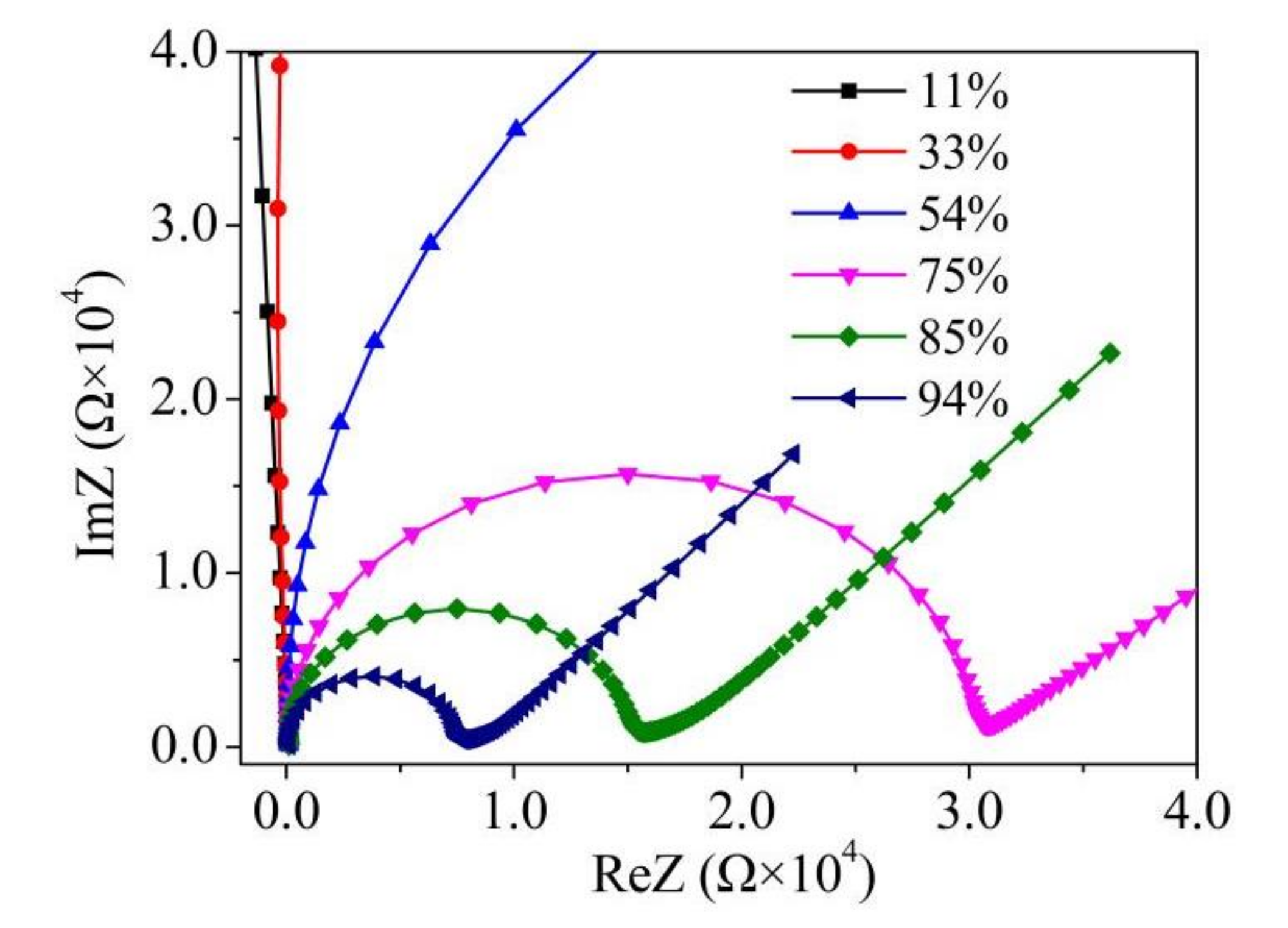
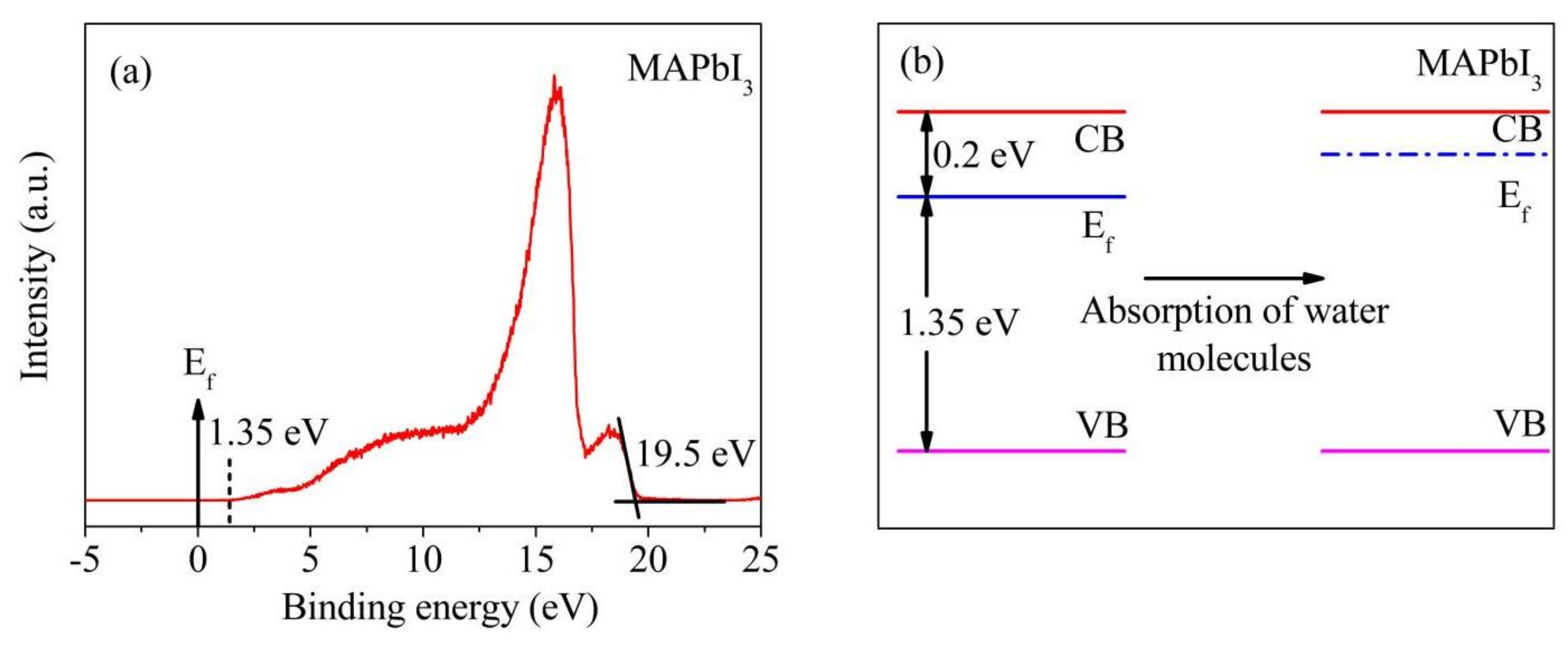
| Hysteresis | Response Time (s) | Recovery Time (s) | |
|---|---|---|---|
| MAPbI3-based sensor | Max = 18.61% (75%RH) Min = 6.76% (11%RH) | 64 (11%→33%) | 90 (33%→11%) |
| 56 (11%→54%) | 89 (54%→11%) | ||
| 77 (11%→75%) | 131 (75%→11%) | ||
| 56 (11%→85%) | 134 (85%→11%) | ||
| 31 (11%→94%) | 148 (94%→11%) |
Publisher’s Note: MDPI stays neutral with regard to jurisdictional claims in published maps and institutional affiliations. |
© 2022 by the authors. Licensee MDPI, Basel, Switzerland. This article is an open access article distributed under the terms and conditions of the Creative Commons Attribution (CC BY) license (https://creativecommons.org/licenses/by/4.0/).
Share and Cite
Zhao, X.; Sun, Y.; Liu, S.; Chen, G.; Chen, P.; Wang, J.; Cao, W.; Wang, C. Humidity Sensitivity Behavior of CH3NH3PbI3 Perovskite. Nanomaterials 2022, 12, 523. https://doi.org/10.3390/nano12030523
Zhao X, Sun Y, Liu S, Chen G, Chen P, Wang J, Cao W, Wang C. Humidity Sensitivity Behavior of CH3NH3PbI3 Perovskite. Nanomaterials. 2022; 12(3):523. https://doi.org/10.3390/nano12030523
Chicago/Turabian StyleZhao, Xuefeng, Yuting Sun, Shuyu Liu, Gaifang Chen, Pengfei Chen, Jinsong Wang, Wenjun Cao, and Chunchang Wang. 2022. "Humidity Sensitivity Behavior of CH3NH3PbI3 Perovskite" Nanomaterials 12, no. 3: 523. https://doi.org/10.3390/nano12030523
APA StyleZhao, X., Sun, Y., Liu, S., Chen, G., Chen, P., Wang, J., Cao, W., & Wang, C. (2022). Humidity Sensitivity Behavior of CH3NH3PbI3 Perovskite. Nanomaterials, 12(3), 523. https://doi.org/10.3390/nano12030523







